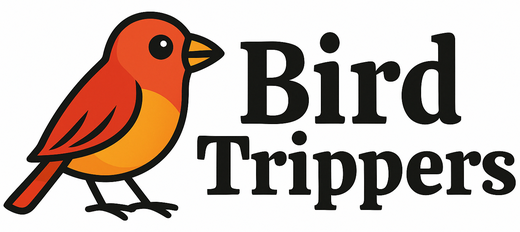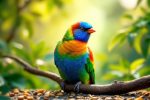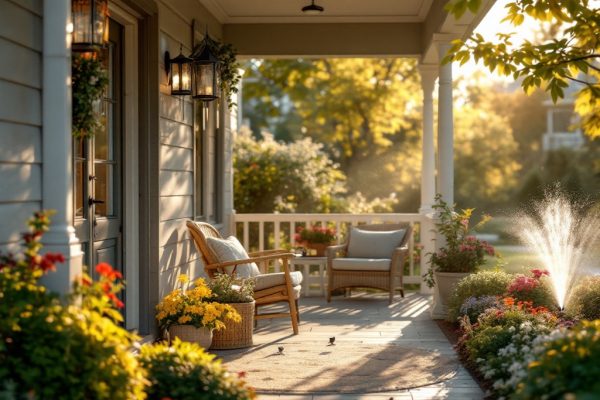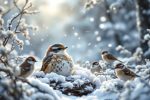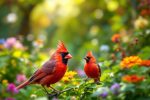How to Stop Birds from Nesting on Your Balcony
Tired of birds turning your balcony into their personal nest? Discover how their nesting habits create unsanitary conditions and damage, impacting your outdoor enjoyment. Learn effective and humane methods to deter birds, from netting and spikes to visual and sound deterrents, all while respecting wildlife and the Migratory Bird Treaty Act. Reclaim your balcony today and keep it bird-free with our expert advice and practical solutions. Read on to learn more!
Important information

- Birds are attracted to balconies for nesting because they offer height, shelter, and proximity to food and water.
- Nests on balconies can create unsanitary conditions, drainage issues, and noise problems.
- Effective deterrents include netting, spikes, visual deterrents (like reflective tape and predator decoys), and motion-activated lights.
- The Migratory Bird Treaty Act protects active nests, making removal illegal without a permit. Inactive nests can be removed with precautions.
- Regular cleaning and maintenance are crucial for preventing future nesting.
Understanding Bird Behavior and Nesting Habits
Birds often choose balconies as nesting sites, drawn by their height and perceived safety. These elevated spots provide shelter from weather and predators, making them appealing nurseries. Ornithologists confirm this preference, noting that factors like easy access, available cover, and closeness to food and water sources also contribute to nest site selection. Understanding these factors can help people prevent balcony nests.
Why Birds Choose Balconies for Nesting
Balconies provide birds with a sheltered area, much like natural nests, protecting them from predators and harsh weather conditions.
Their elevated position gives birds a great vantage point, and cities offer easy access to food sources. This makes balconies appealing nesting spots, attracting birds to these convenient urban havens.
The Impact of Birds Nesting on Balconies
Bird nests on balconies, while seemingly charming, can present several challenges for residents. Bird droppings can stain and create unsanitary conditions, posing potential health risks due to pathogens they may carry. Nesting materials often clog drains and gutters, leading to further maintenance issues. The accumulation of droppings creates a slippery hazard, and combined with the noise and general mess, can make balconies unusable and prevent residents from enjoying their outdoor space.
Effective Bird Control Methods for Balconies
Bird Netting
Bird netting effectively creates a physical barrier, preventing birds from accessing your balcony. Available in various mesh sizes and materials like nylon or polyethylene, it’s crucial to ensure a tight and secure installation to eliminate any gaps.
Bird Spikes
Bird spikes, typically made of stainless steel or plastic, deter birds from landing on balcony railings. They come in various lengths and designs, so choose appropriately for your space, ensuring firm attachment and full coverage.
Visual Deterrents
Visual deterrents capitalize on birds’ natural aversions. Shiny balloons, reflective tape, or moving objects like wind chimes and spinners can be strategically placed for optimal effectiveness.
Motion-Activated Strobe Lights
Motion-activated strobe lights use bursts of bright light to scare birds away, triggered by movement. Especially effective at night, these lights startle birds and can be combined with other deterrents for enhanced results.
Using Bird Netting to Stop Nesting Birds
Bird netting is a great way to protect your balcony and prevent birds from nesting. Choose strong, weather-resistant netting and make sure it’s firmly attached, covering all possible nesting spots. Check the netting regularly for damage and ensure it’s safe for other animals. Proper installation is key for effectiveness.
Installing Bird Spikes to Prevent Roosting
Bird spikes prevent birds from landing by creating an uneven surface, making it difficult for them to settle. These spikes, typically made of plastic or stainless steel, are most effective when installed on ledges, railings, or any flat surface where birds congregate. This deters roosting and keeps these areas bird-free.
Implementing Visual Deterrents
Creating an Unwelcoming Environment
Deter birds by making the area less appealing. Shiny objects, such as reflective tape or foil, can disorient birds and make the space undesirable. Hanging scare balloons or predator balloons, especially those with large eyespots, can also be effective deterrents.
Mimicking Predators and Disrupting the Area
While plastic owls and hawks mimic predators, remember to move these decoys frequently. Birds can quickly adapt to stationary objects, reducing their effectiveness. Wind spinners and other moving decorations create an unsettled atmosphere, making it less attractive for birds to land.
How Motion-Activated Strobe Lights Deter Birds
Motion-activated strobe lights effectively deter birds by emitting sudden bursts of light that startle them and disrupt their sense of security. This makes balconies less appealing for landing and nesting, encouraging birds to seek safer havens.
Humane and Wildlife-Friendly Deterrent Options
Deter birds from your property with shiny objects like old CDs or aluminum foil. Their reflective surfaces flash light, startling birds with unpredictable movement. Placing decoys, such as owls or hawks, creates the illusion of a predator. Reflective tape and wind chimes also work well, combining visual distractions with unsettling sounds. Birds dislike sudden movements and unfamiliar noises and will avoid areas they perceive as threatening. Here’s a breakdown of these deterrents:
Visual Deterrents
- Shiny objects, such as old CDs or aluminum foil, flash light and startle birds.
- Decoys of predators, like owls or hawks, create a perceived threat.
- Reflective tape disorients birds with unpredictable flashes of light.
Auditory Deterrents
- Wind chimes produce unsettling sounds that discourage birds.
The Benefits of Shiny Hanging Objects
Shiny objects, like CDs or aluminum foil strips, deter birds by reflecting light. These unpredictable flashes compromise their sense of safety, discouraging nesting. Other effective deterrents include reflective tape and wind chimes.
Using Decoys and Reflective Objects
Use decoys of predator birds like owls or hawks to deter smaller birds.
Utilize reflective objects such as pinwheels, metallic tape, or old CDs to create unsettling flashes of light.
Deploy scare balloons with predator eye patterns as another effective deterrent.
Regularly reposition the deterrents to prevent habituation and maintain their effectiveness.
Preventative Measures for Future Nesting
Thin fishing line offers a humane way to deter birds from railings. The taut, closely spaced lines, only a few inches apart, disorient birds and discourage them from landing or nesting. Seeing the nearly invisible barrier, they will simply choose a more welcoming spot. This easy and affordable solution keeps railings clear without harming birds.
Running Fishing Line Along Railings
Fishing line’s instability disrupts birds’ balance, making it difficult for them to land, perch, or nest. For an effective deterrent, string multiple lines 2 to 4 inches apart.
Legal and Safe Removal of Bird Nests
The Migratory Bird Treaty Act protects most native North American birds, including their nests, eggs, and young. Disturbing or removing an active nest—one containing eggs or young birds—is illegal. If you need to remove a nest, consult your local regulations, as permits may be required. Inactive nests, however, can be safely removed. To protect yourself from potential diseases and parasites, wear gloves and a mask. Seal the nest in a bag for disposal and thoroughly clean the area to discourage rebuilding.
Observe the nest from a distance to determine if it’s active.
If the nest is inactive, wait a few days in case the birds return.
Protect yourself with gloves and a mask.
Gently remove the nest.
Dispose of the nest properly.
Disinfect the area.
Understanding the Migratory Bird Act
The Migratory Bird Treaty Act (MBTA) protects over 1,000 bird species. Disturbing, damaging, or removing active nests is illegal without a permit. Contact your local U.S. Fish and Wildlife Service office for permitting details and answers to any questions.
How to Safely Check and Remove a Nest
Check the nest for eggs or chicks.
If present, leave them undisturbed until they fledge.
Should nest removal be absolutely necessary and legally permitted, take precautions.
Protect yourself by wearing gloves and carefully remove the nest.
Afterwards, clean the area with a bleach solution.
Cleaning and Maintaining a Bird-Free Balcony
Maintaining a bird-free balcony requires regular upkeep and vigilance. Frequently remove debris such as twigs, leaves, and old nests, as these materials attract birds for nesting. Regularly inspect your balcony for any signs of bird activity, including droppings, feathers, or nests hidden in corners, on railings, or under furniture. Ensure that any bird deterrents you’ve installed, like netting or spikes, are effective and in good repair. Avoid leaving out food or water sources, as these can attract birds. Cover or store any potential food sources to further discourage birds from visiting your balcony. Consistent cleaning and attention to these details will help keep your balcony bird-free.
Regular Maintenance and Inspection Tips
Regularly inspect your balcony for nests, droppings, or any signs of bird activity. Remove any potential nesting materials like twigs, leaves, and feathers.
Ensure bird deterrents, such as netting or spikes, are securely in place and functioning effectively.
Frequently clean your balcony to make the area less attractive to birds, discouraging them from landing and roosting.
Advice from Wildlife Experts
Are you troubled by birds on your balcony? Wildlife experts can create a personalized plan to address this issue. They consider the specific bird species and your balcony’s layout to recommend humane deterrents. They also advise on regulations regarding nest removal and provide preventative measures, like safe cleaning practices to discourage future nesting. Consulting a professional ensures your bird control methods are both effective and ethical. Contact an expert today for assistance.
Consulting Professional Bird Control Services
Troubled by birds on your balcony? Bird control professionals offer expert help, understanding both bird behavior and local laws. They humanely remove birds and assess your specific balcony situation to recommend customized solutions. These experts effectively install deterrents like netting and spikes, ensuring you comply with laws such as the Migratory Bird Treaty Act. This protects both your property and the birds.
Choosing the Right Bird Repellents
Effective bird control depends on choosing the right repellent for the specific species and their nesting habits.
Visual Deterrents
Disorient birds with visual deterrents such as:
- Reflective tape,
- Old CDs,
- Shiny foil.
Predator decoys, like owls or hawks, can scare off smaller species.
Physical Barriers
Bird spikes prevent landing and nesting.
Netting effectively blocks access to nesting areas.
Sound deterrents, which mimic predator calls, are another option. Remember to prioritize humane methods and check local regulations. Rotating these deterrents prevents birds from adapting, maintaining their effectiveness.
